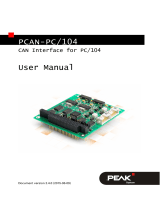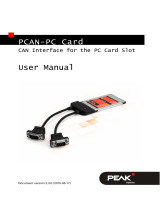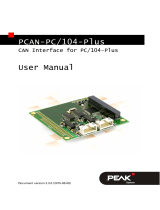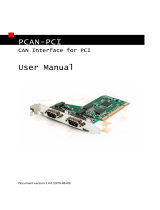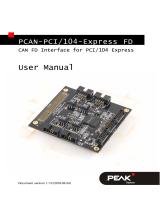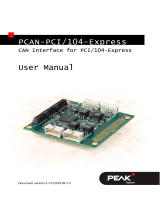Page is loading ...

CAN Interface for PC/104
User Manual
PCAN-PC/104
V2.2.3

PCAN-PC/104 – User Manual
2
Products taken into account
Product Name Model Part number
PCAN-PC/104 Single Channel One CAN channel IPEH-002054
PCAN-PC/104 Dual Channel Two CAN channels IPEH-002055
PCAN-PC/104 Single Channel
opto-decoupled
One CAN channel, galvanic
isolation for CAN connection
IPEH-002056
PCAN-PC/104 Dual Channel
opto-decoupled
Two CAN channels, galvanic
isolation for CAN connections
IPEH-002057
The cover picture shows the product PCAN-PC/104 Dual Channel opto-decoupled.
Other product models have an identical form factor but vary in equipment.
CANopen® and CiA® are registered communi
ty trade marks of CAN in Automation
e.V.
All other product names mentioned in this document may be the trademarks or
registered trademarks of their respective companies. They are not explicitly marked
by “™” and “®”.
© 2013 PEAK-System Technik GmbH
PEAK-System Technik GmbH
Otto-Roehm-Strasse 69
64293 Darmstadt
Germany
Phone: +49 (0)6151 8173-20
Fax: +49 (0)6151 8173-29
www.peak-system.com
info@peak-system.com
Documen
t version 2.2.3 (2013-03-20)

PCAN-PC/104 – User Manual
3
Contents
1 Introduction 5
1.1 Properties at a Glance 5
1.2 System Requirements 6
1.3 Scope of Supply 7
2 Installing and Configuring the Software and the
Card 8
2.1 Configuring the Card 8
2.1.1 Interrupt 9
2.1.2 I/O Address Range 10
2.2 Installing the Software and the Card 12
2.3 Modifying the Computer's BIOS Settings 13
2.3.1 Indicating Used Interrupts 14
2.3.2 Deactivating the APIC Mode 14
3 Connecting the CAN Bus 16
3.1 D-Sub Connector 16
3.2 Supplying External Devices via the CAN
Connector 18
3.3 Cabling 20
3.3.1 Termination 20
3.3.2 Example of a Connection 20
3.3.3 Maximum Bus Length 21
4 Using the Software 22
4.1 PCAN-View for Windows 22
4.1.1 Receive/Transmit Tab 25
4.1.2 Trace Tab 27
4.1.3 Status Bar 28
4.2 Linking Own Programs with PCAN-Basic 29
4.2.1 Features of PCAN-Basic 30

PCAN-PC/104 – User Manual
5
1 Introduction
The PCAN-PC/104 is a compact PC/104 CAN card which allows the
networking of one or two CAN busses to a PC/104 system. Device
drivers and programming interfaces exist for different operating
systems, so programs can easily access a connected CAN bus.
Tip: At the end of this manual (Appendix C) you can find a
Quick Reference with brief information about the installation
and operation of the PCAN-PC/104 card.
1.1 Properties at a Glance
Form factor PC/104
Multiple PC/104 cards can be operated in parallel (interrupt
sharing)
14 port and 8 interrupt addresses are available for configuration
using jumpers
1 or 2 High-speed CAN channels (ISO 11898-2)
Compliant with CAN specifications 2.0A (11-bit ID)
and 2.0B (29-bit ID)
NXP CAN controller SJA1000, 16 MHz clock frequency
NXP CAN transceiver PCA82C251
CAN bus connection via D-Sub, 9-pin (in accordance with
CiA® 102)
Bit rates up to 1 Mbit/s
Galvanic isolation up to 500 V for the CAN interface (only opto-
decoupled models), separate for each CAN channel

PCAN-PC/104 – User Manual
6
5-Volt power supply at the CAN connector connectible by solder
jumpers, e.g. for external bus converter
Extended operating temperature range of -40 to +85 °C (-40 to
+185 °F)
Note: This manual describes the use of the PCAN-PC/104 card
with Windows. You can find device drivers for Linux and the
corresponding application information on the provided DVD in
the directory branch Develop and on our website under
www.peak-system.com/linux.
1.2 System Requirements
PC/104 stack with ISA bus (according to the PC/104 specification)
Operating system Windows 8, 7, Vista, XP (32-bit),
or Windows CE 6.x (x86 and ARMv4 processor support),
or Linux (32-bit)

PCAN-PC/104 – User Manual
7
1.3 Scope of Supply
PCAN-PC/104 card
Slot bracket with D-Sub connector(s) for the CAN bus
connection
Device drivers for Windows 8, 7, Vista, XP (32-bit)
and Linux (32-bit)
Device driver for Windows CE 6.x
(x86 and ARMv4 processor support)
PCAN-View CAN monitor for Windows 8, 7, Vista, XP (32/64-bit)
PCAN-View CAN monitor for DOS
PCAN-Basic programming interface consisting of an interface
DLL, examples, and header files for all common programming
languages
Manual in PDF format

PCAN-PC/104 – User Manual
8
2 Installing and Configuring
the Software and the Card
This chapter covers the configuration, the software setup for the
PCAN-PC/104 card under Windows, and the card installation in the
computer.
2.1 Configuring the Card
Before installing the PCAN-PC/104 card into the computer you may
need to configure it. For each CAN channel an interrupt (IRQ) and an
I/O address range is set for operation in the computer.
At delivery the PCAN-PC/104 card has the following default settings:
CAN Channel IRQ I/O Address Range Comment
1 10 300h – 31Fh
2 5 320h – 33Fh Dual Channel model only
Tip: If the given resources are not permanently allocated by
other devices, you can skip the configuration and directly
continue with the following manual section 2.2 on page 12.
For a configuration differing from the default settings you need to
set jumpers on the PCAN-PC/104 PCB according to the following
explanations.
Attention! Electrostatic discharge (ESD) can damage or destroy
components on the PCAN-PC/104 card. Take precautions to
avoid ESD when handling the card.

PCAN-PC/104 – User Manual
9
2.1.1 Interrupt
An interrupt (IRQ) must be assigned to each CAN channel. This is
done with a single jumper on jumper field JP1 for CAN channel 1
and jumper field JP2 for CAN channel 2 (latter refers only to the
Dual Channel model). The PCAN-PC/104 card supports the inter-
rupts 3, 4, 5, 7, 10, 11, 12, and 15. The default setting at delivery for
CAN channel 1 is interrupt 10, for CAN channel 2 interrupt 5.
Figure 1: Position of the jumper fields for setting the interrupts,
JP1 for CAN channel 1 (lower jumper field),
JP2 for CAN channel 2 (upper jumper field,
Dual Channel model only)
It is possible to share the same interrupt between two existing CAN
channels. Therefore you can configure the same interrupt when
using two PCAN-PC/104 cards in the same computer.
Tip: We suggest to configure different interrupts as long as
resources allow it and use interrupt sharing only if this is not
the case.

PCAN-PC/104 – User Manual
10
2.1.2 I/O Address Range
Each CAN channel must be assigned to an unique I/O address range
in the computer. An address space from 200h up to 39Fh and 3E0h
to 3FFh (h = hexadecimal) is available. PCAN-PC/104 uses 32 addres-
ses beginning from the configured base address. The configuration
is done on jumper field JP3 for CAN channel 1 and jumper field JP4
for CAN channel 2 (latter refers only to the Dual Channel model).
One or several jumpers are needed for each jumper field.
Figure 2: Position of the jumper fields for setting the I/O base addresses,
JP3 for CAN channel 1 (left jumper field),
JP4 for CAN channel 2 (right jumper field, Dual Channel model only)
The following table shows the possible settings. The X stands for a
set jumper. The default settings at delivery for CAN channels 1 and
2 are highlighted.
Continued on the next page

PCAN-PC/104 – User Manual
11
Jumper field JP3/JP4
A B C D E
I/O address range
X 200h – 21Fh
X X 220h – 23Fh
X X 240h – 25Fh
X X X 260h – 27Fh
X X 280h – 29Fh
X X X 2A0h – 2BFh
X X X 2C0h – 2DFh
X X X X 2E0h – 2FFh
X X 300h – 31Fh
X X X 320h – 33Fh
X X X 340h – 35Fh
X X X X 360h – 37Fh
X X X 380h – 39Fh
X X X X X 3E0h – 3FFh

PCAN-PC/104 – User Manual
12
2.2 Installing the Software and the Card
Setup the driver before inserting the card.
Do the following to install the driver:
1. Make sure that you are logged in as user with administrator
privileges (not needed for normal use of the card later on).
2. Insert the supplied DVD into the appropriate drive of the
computer. Usually a navigation program appears a few
moments later. If not, start the file Intro.exe from the root
directory of the DVD.
3. On the page English > Drivers activate the entry PCAN-ISA.
4. Click on Install now. The setup program for the driver is
executed.
5. Follow the instructions of the program.
Tip: If you do not want to install the CAN monitor PCAN-View
for Windows onto the hard disk together with the driver, you
have the option to start the program later directly from DVD
without prior installation.
Do the following to install the PCAN-PC/104 card in the
computer:
Attention! Electrostatic discharge (ESD) can damage or destroy
components on the PCAN-PC/104 card. Take precautions to
avoid ESD when handling the card.
Shut down the computer.
6. Disconnect the computer from the power supply.
7. Plug the PCAN-PC/104 card onto a PC/104 connector. For
details refer to the documentation of the computer.

PCAN-PC/104 – User Manual
13
8. Interconnect the connector for each CAN channel on the
PCAN-PC/104 card (see Figure 3) with the CAN connector of
the slo
t bracket using the attached flat cable.
Figure 3: Connectors for the flat cables to the CAN connectors,
J3 for CAN channel one (lower position),
J4 for CAN channel 2 (upper position, Dual Channel model only)
9. Reconnect the power supply of the computer.
Note: Before switching on the computer, please follow the pro-
cedure for modifying the computer's BIOS settings described in
the following section.
2.3 Modifying the Computer's BIOS Settings
To ensure a flawless operation of the PCAN-PC/104 card it is neces-
sary that you adjust settings in the BIOS setup of the computer:
Indicate used interrupts
Deactivate the APIC mode

PCAN-PC/104 – User Manual
14
Note: Due to a diversity of existing BIOS setup versions for
computers we cannot give detailed instructions here. Instead
we indicate common setting names.
In order to know how to start the computer's BIOS setup please
consult the corresponding documentation. Usually you can enter
the BIOS setup by pressing the Del or F2 key shortly after switching
on the computer.
2.3.1 Indicating Used Interrupts
By indicatin
g the interrupts that are set on the PCAN-PC/104 card,
you avoid that the corresponding resources are automatically
assigned to other devices and that this results in conflicts.
In the BIOS setup itself you can often find the settings for the
interrupts under a menu item containing the text “PnP”. For the
interrupt(s) used by PCAN-PC/104 change the setting to “Reserved”
or “Legacy ISA”.
2.3.2 Deactivating the APIC Mode
Note: Do not mix up APIC with ACPI.
The APIC mode is a certain type of interrupt management in a
computer.
If the APIC mode is active in your computer, you must deactivate it
so that the PCAN-PC/104 card can work properly with interrupts.
Do the following to determine in Windows if the APIC mode is
active:
Open the Windows Device Manager.
10. Select the menu entry View > Resources by type.

PCAN-PC/104 – User Manual
15
11. Open the branch of Interrupt request (IRQ).
If entries with interrupt numbers greater than 15 are listed,
the APIC mode is active and you must deactivate it.
Do the following to deactivate the APIC mode:
Important note: When you deactivate the APIC mode in the
BIOS setup, it may happen that you must reinstall Windows
afterwards, because it cannot start anymore due to the low-
level setting.
Restart the computer and switch to the BIOS setup.
12. Search for the APIC setting and deactivate it.
13. Save the changes in the BIOS and quit the BIOS setup.
14. If Windows doesn't start properly, reinstall it or perform a
repair installation.

PCAN-PC/104 – User Manual
16
3 Connecting the CAN Bus
3.1 D-Sub Connector
A High-speed CAN bus (ISO 11898-2) is connected to the 9-pin
D-Sub connector. The pin assignment corresponds to the
specification CiA® 102.
Figure 4: Pin assignment High-speed CAN
(view onto connector of the slot bracket)
With the pins 1 and 9 devices with low power consumption (e.g. an
external bus converter) can be directly supplied via the CAN con-
nector. At delivery these pins are not assigned. You can find a
detailed description about the activation in the following section 3.2.

PCAN-PC/104 – User Manual
17
The pin assignment between the D-Sub port and the 10-pin connec-
tor on the PCAN-PC/104 card is as follows:
Figure 5: Numbering at the 10-pin connector
Pin Assignment
Assignment
D-Sub
1 +5 V (optional) 1
2 GND 6
3 CAN_L 2
4 CAN_H 7
5 GND 3
6 not connected 8
7 not connected 4
8 +5 V (optional) 9
9 not connected 5
10 not connected
Tip: You can connect a CAN bus with a different transmission
standard via a bus converter. PEAK-System offers different bus
converter modules (e.g. PCAN-TJA1054 for a Low-speed CAN
bus according to ISO 11898-3).

PCAN-PC/104 – User Manual
18
3.2 Supplying External Devices via the CAN
Connector
You can route a 5-Volt supply to pin 1 and/or pin 9 of the CAN con-
nector (independently for each CAN connector on the Dual Channel
model) by setting solder jumpers on the PCAN-PC/104 card. Thus
devices with low power consumption (e.g. a bus converter) can be
directly supplied via the CAN connector.
When using this option the 5-Volt supply is connected to the power
supply of the computer and is not fused separately. The opto-
decoupled models of the card contain an interconnected DC/DC
converter. Therefore the current output is limited to about 50 mA.
Proceed as follows to activate the 5-Volt supply:
Attention! Electrostatic discharge (ESD) can damage or destroy
components on the PCAN-PC/104 card. Take precautions to
avoid ESD when handling the card.
Set the solder jumpers on the PCAN-PC/104 card according to the
desired settings. During this procedure take especially care not to
produce unwanted short circuits on the card.
Figure 6 shows the positions of the solder fields on the PCAN-
PC/104 ca
rd. The table below contains the possible settings.

PCAN-PC/104 – User Manual
19
Figure 6: Position of the solder jumper fields for the 5-Volt supply
(JP5 lower position, JP6 upper position)
5-Volt supply →
None Pin 1 Pin 9 Pin 1 + Pin 9
JP5 (CAN channel 1) /
JP6 (CAN channel 2)
Attention! Risk of short circuit! If the option described in this
section is activated, you may only connect or disconnect CAN
cables or peripheral systems (e.g. an external bus converter) to
or from the PCAN-PC/104 card while the computer is de-
energized.

PCAN-PC/104 – User Manual
20
3.3 Cabling
3.3.1 Termination
A High-speed CAN bus (ISO 11898-2) must be terminated on both
ends with 120 Ohms. Otherwise, there are interfering signal reflec-
tions and the transceivers of the connected CAN nodes (CAN inter-
face, control unit) will not work.
The PCAN-PC/104 card does not have an internal termination. Use
the adapter on a terminated CAN bus.
3.3.2 Example of a Connection
Figure 7: Simple CAN connection
In this example, the PCAN-PC/104 card is connected with a control
unit by a cable that is terminated at both ends.
/

